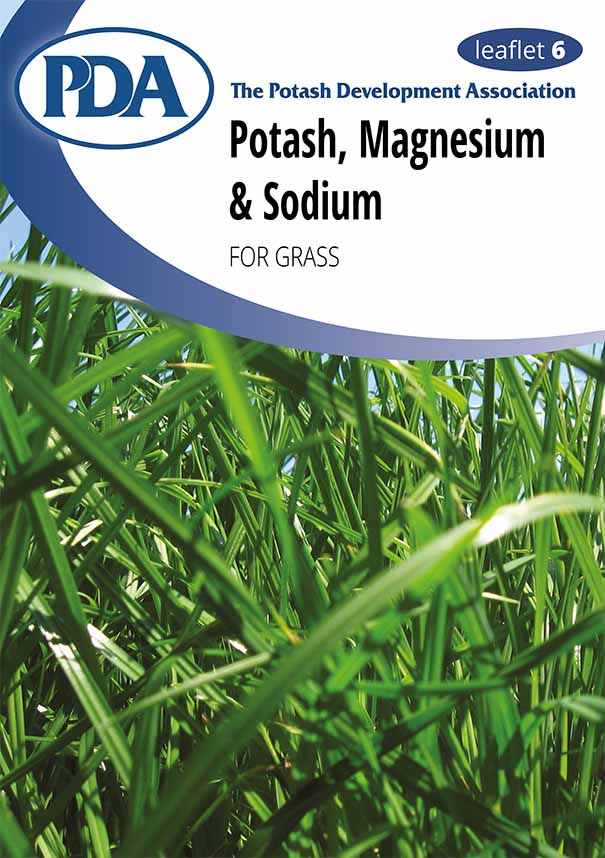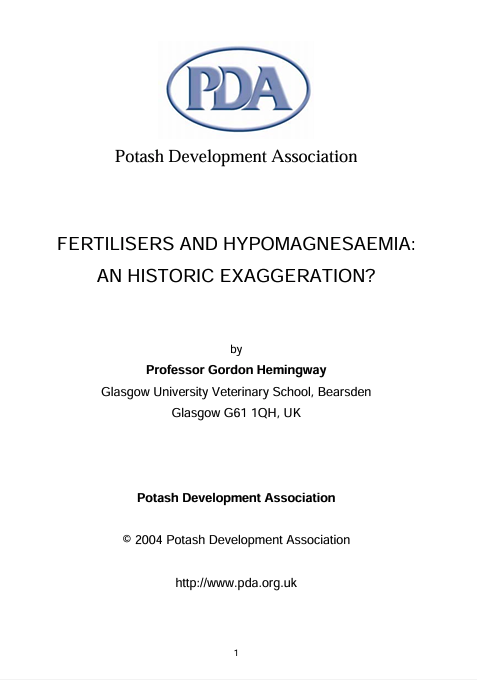Download pdf: Magnesium and Sodium for Grass (3.08M)
pdf 3.08M
Magnesium and Sodium for Grass
December 2023
Natural mineral content of grass
The natural pattern of uptake of minerals such as Potassium (K), Magnesium (Mg), Sodium (Na) and Calcium (Ca) varies during the course of the growing season. The dry matter of young rapidly growing grass, especially in the spring, has a high K content when dry matters are low which declines as the season progresses, whilst the concentration of other minerals increases through the summer.
Nutrient uptake
The application of a correct balance of nitrogen, phosphate, potash and sulphur is required to obtain the optimal yield and quality of low-cost on-farm forage. In addition to their effect on yield, N and K fertilisers influence the mineral content of grass, especially Mg, Na, and Ca. Adequate nitrogen will tend to stimulate the uptake of all minerals but the ease with which plant roots absorb different nutrients varies:
This is in line with the needs of grass, which for optimum growth requires large amounts of potassium and lesser amounts of magnesium and sodium. For animals however, the balance of requirements is for more magnesium and sodium and only modest amounts of potassium. An adequate supply and balance of these minerals is important to minimise the risk of metabolic disorders such as hypomagnesaemia (staggers or grass tetany) and milk fever and to ensure fertility.
Potash in perspective
Increasing the uptake of one nutrient by plants may affect the level of others, but it is wrong to assume that the application of potash automatically leads to mineral disorders. The effect of potash fertiliser on herbage mineral content will vary widely in different situations. Figure 1 shows how magnesium and sodium levels in the plant may decrease as a result of potash application. However, this is not always the case and the application of potash may not have any effect on the sodium or magnesium levels.
Nutrient balance
Nutrient balance is important in avoiding mineral disorders and experimental work has shown that there is less risk of staggers when potassium, magnesium and sodium levels in herbage result in K:Na and K:Mg ratios of between 10 and 20:1. The bar chart below indicates the greater risk of staggers at K:Na ratios greater than 20:1. Field trials and surveys have shown that maintaining a high level of sodium and magnesium in grass will reduce the risk of staggers.
The PDA Technical Note Fertilisers and Hypomagnesaemia: An Historic Exaggeration? written by the late Professor Gordon Hemingway from Glasgow University Veterinary School provides an insight into the link between high nitrogen and potassium fertiliser applications and the incidence of clinical tetany and how this may have been overstated in previous research work.
The place for sodium
Sodium fertilisers will not normally give extra grass yield but they will improve the palatability of herbage and may reduce the chance of grass staggers. Studies have found that dry matter intake of herbage containing 0.2 – 0.5% Na was increased by 12 – 18% when sodium-containing fertiliser was applied, perhaps due to longer times of grazing shorter length material.
Sodium is also associated with higher D values and sugar content of grass. Research from Bangor University indicates that these effects increase milk output and percentage butterfat and may also have a small benefit on somatic cell count. Grass palatability and milk output increase at herbage sodium levels up to 0.5% in the dry matter.
Fertilise to balance potassium, magnesium and sodium
The sodium and magnesium content of grassland can be improved by using sodium and magnesium fertilisers to balance the levels of K required for grass production. Extra minerals may be required for high yielding dairy cows and lactating sheep. Feed analysis should be used to confirm supplements required.
Slurry
Slurry is a valuable source of minerals, containing a little sodium, some magnesium and a lot of potash. Modest applications of slurry may increase K and Mg levels in herbage. With larger applications however, the high concentrations of potassium tend to depress both Na and Mg levels. The nutrient contribution of slurry should be taken into account when deciding fertiliser policy. In particular, spring potash dressings should be adjusted when slurry has been applied over winter to avoid excess levels of K being available to the grass in the spring.
Potassium, magnesium and sodium in the animal
Much of the sodium consumed by cattle and sheep is used in the saliva which is secreted into the rumen to maintain a constant pH by neutralising acids formed by bacteria in the rumen liquor. If the sodium content of forage is too low, the animal automatically substitutes potassium for sodium as an alternative buffer in the saliva and diverts sodium to maintain blood Na level as first priority.
The resulting increase in K:Na ratio in the rumen leads to reduced resorption of Magnesium through the rumen wall into the blood – hence placing the animal at risk of hypomagnesaemia. However, it is only in extreme cases that a low blood level of magnesium occurs (less than 1.8mg/100ml of blood in cows) and the consequences of the condition (reduced milk yield and even death) may arise without ever detecting low blood Mg.
Timing of application
Grazing
Avoid applying potash between March and June except as small dressings of about 10 kg K2O/ha
Cutting
Apply up to 80-90 kg K2O/ha for each cut according to soil analysis. Make allowance for potash contribution of slurry or manure used. Where larger amounts of potash are required to improve soil reserves additional potash should be applied in the autumn/winter
Magnesium
Low soil magnesium levels will affect grass yield as well as mineral balance in the animal. Apply 50-100 kg/ha MgO every three to four years at Mg index 0. Yield response is less certain at index 1 but magnesium application is justified in terms of insurance for grass yield and mineral balance for the animal, to maintain a soil magnesium index of 2.
Where lime is required and Mg levels are 0 and 1, use magnesian limestone as the most cost-effective magnesium source. Where pH is satisfactory, specific magnesium fertilisers should be used for soil improvement. Use water soluble forms of magnesium where rapid plant uptake is required.
Where potassium and magnesium are required, products including polyhalite may be a suitable option.
Sodium
Sodium is very soluble and is rapidly taken up by plants but levels cannot be built up on a long-term basis as Na is relatively mobile in the soil compared with other cations.
To improve herbage mineral balance, apply up to 140 kg/ha Na2O as an early spring dressing. A split application may be preferable at higher rates.
To improve pasture palatability, apply regular dressings of about 10kg/ha Na2O through the season.

Read the recently updated PDA Leaflet 6: Potassium, Magnesium & Sodium for Grass

There is a very useful technical note available on the PDA website called Fertilisers and Hypomagnesaemia: An Historic Exaggeration? by the late Professor Gordon Hemingway Glasgow University Veterinary School.

